人教版英语七年级下册同步课件unit1-sectionA-3a-3c(33张)
文档属性
| 名称 | 人教版英语七年级下册同步课件unit1-sectionA-3a-3c(33张) | 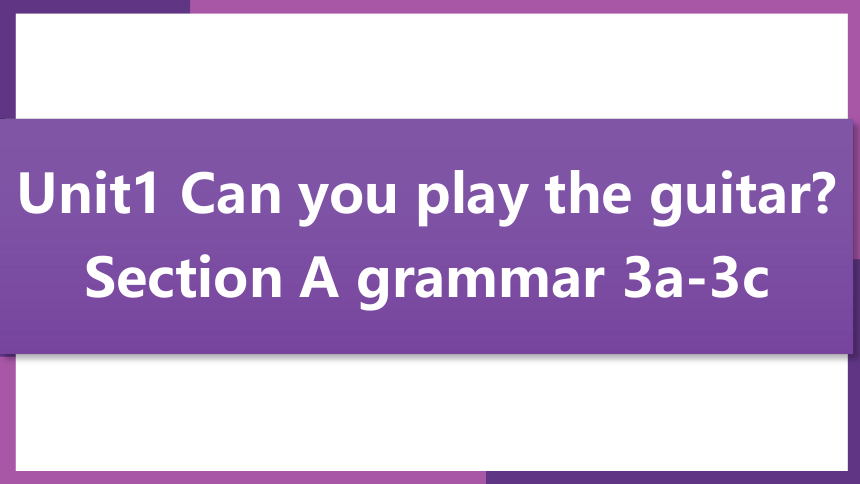 | |
| 格式 | pptx | ||
| 文件大小 | 3.2MB | ||
| 资源类型 | 教案 | ||
| 版本资源 | 人教新目标(Go for it)版 | ||
| 科目 | 英语 | ||
| 更新时间 | 2022-05-30 19:15:46 | ||
图片预览

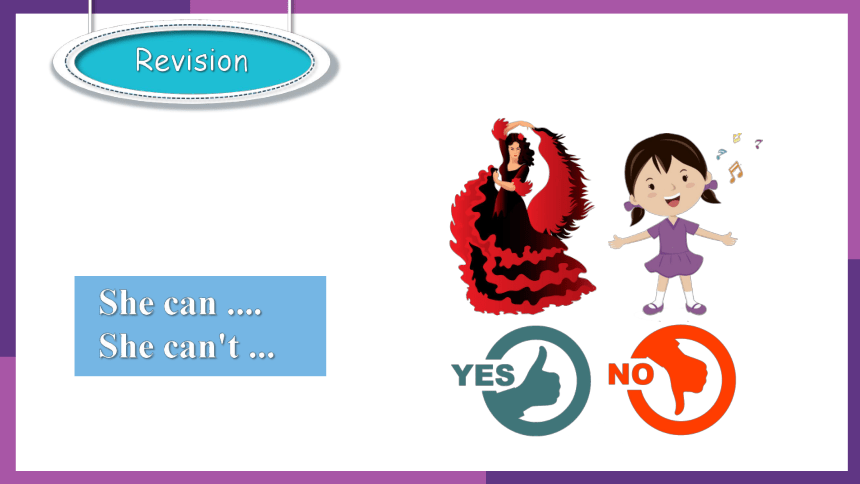

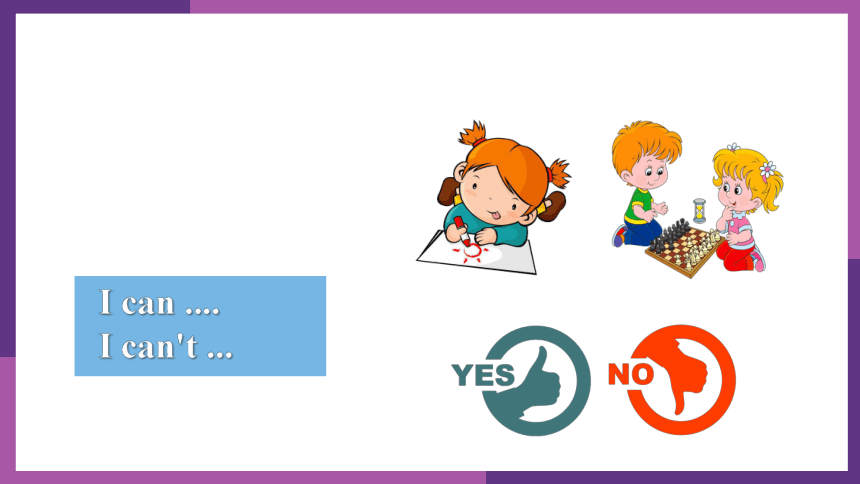
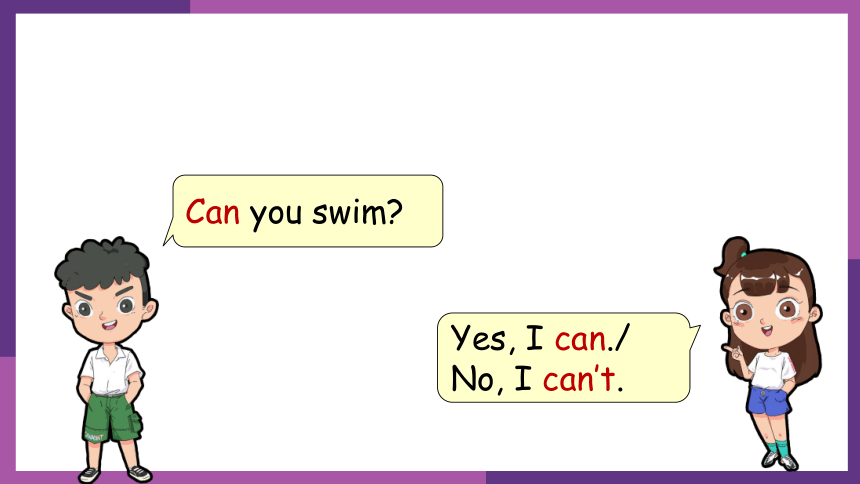
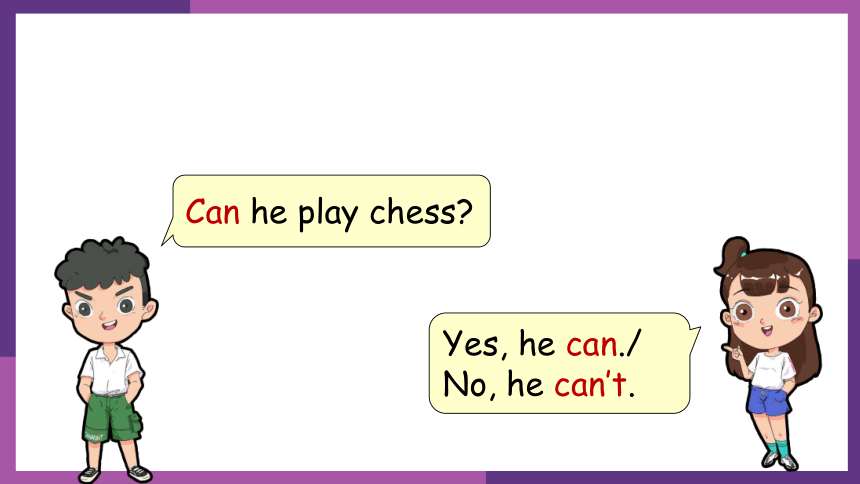

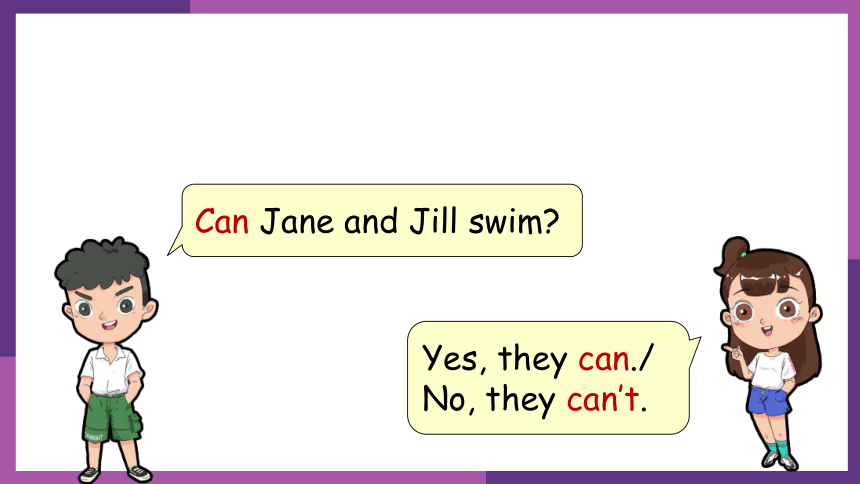
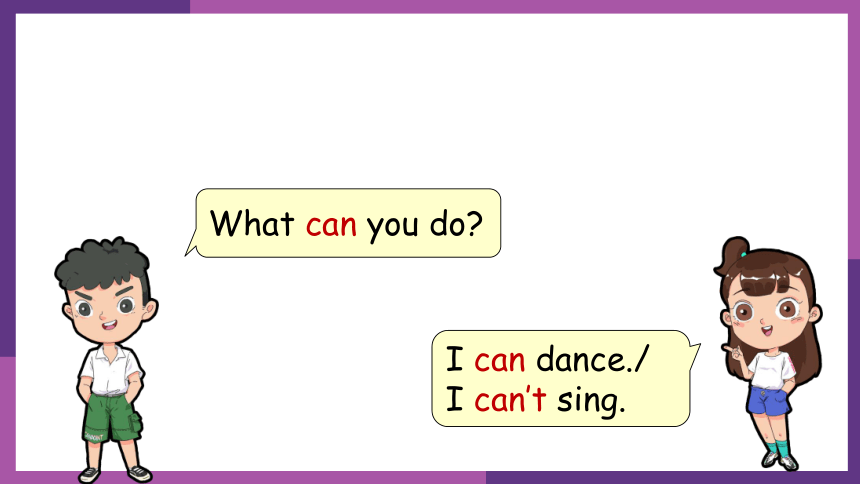
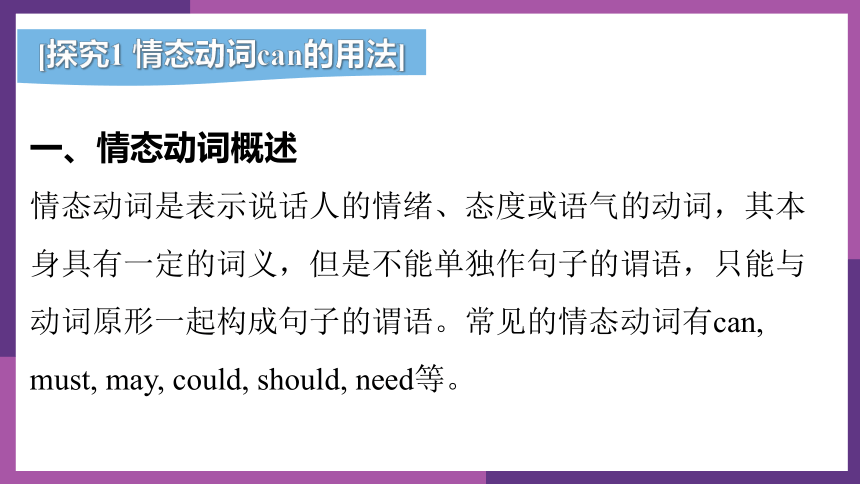
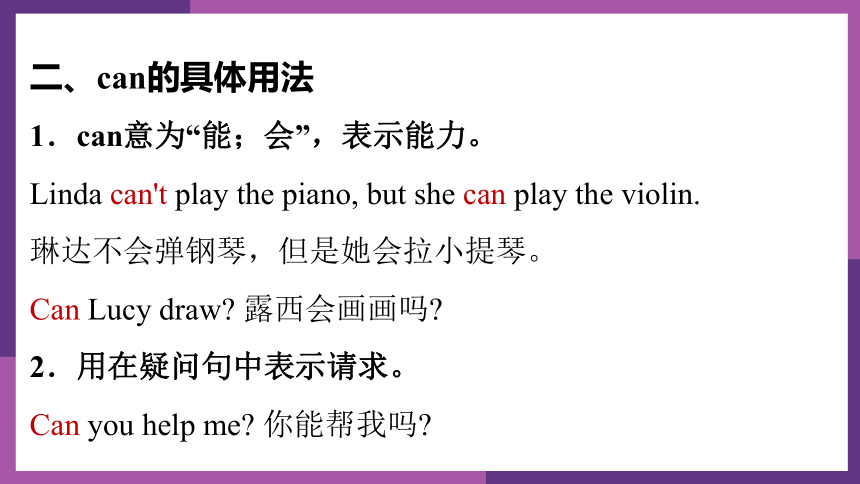
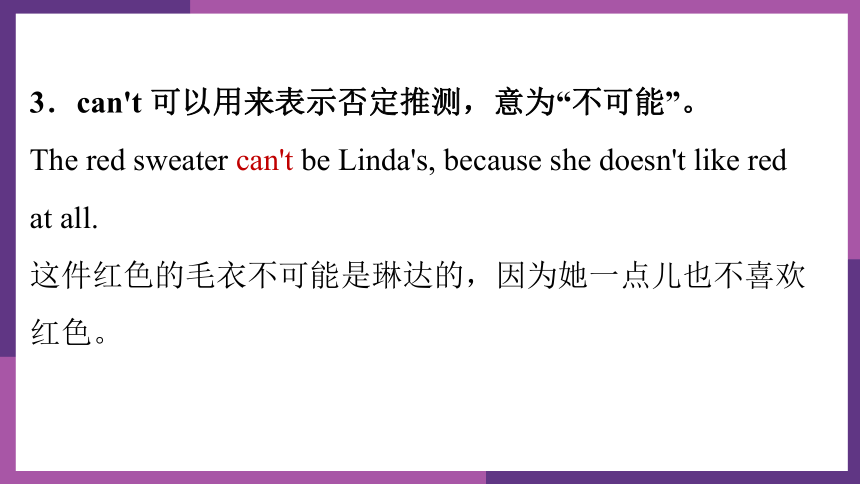
文档简介
(共33张PPT)
Unit1 Can you play the guitar Section A grammar 3a-3c
Revision
She can ....
She can't ...
He can ....
He can't ...
I can ....
I can't ...
Can you swim
Yes, I can./ No, I can’t.
Can he play chess
Yes, he can./ No, he can’t.
Can you and Tom play chess
Yes, we can./ No, we can’t.
Can Jane and Jill swim
Yes, they can./ No, they can’t.
What can you do
I can dance./ I can’t sing.
一、情态动词概述
情态动词是表示说话人的情绪、态度或语气的动词,其本身具有一定的词义,但是不能单独作句子的谓语,只能与动词原形一起构成句子的谓语。常见的情态动词有can, must, may, could, should, need等。
[探究1 情态动词can的用法]
二、can的具体用法
1.can意为“能;会”,表示能力。
Linda can't play the piano, but she can play the violin.
琳达不会弹钢琴,但是她会拉小提琴。
Can Lucy draw 露西会画画吗
2.用在疑问句中表示请求。
Can you help me 你能帮我吗
3.can't 可以用来表示否定推测,意为“不可能”。
The red sweater can't be Linda's, because she doesn't like red at all.
这件红色的毛衣不可能是琳达的,因为她一点儿也不喜欢红色。
3.情态动词can的常用句式
(1)肯定句
主语+can+动词________+其他.
I can find your bag.我能找到你的包。
(2)否定句
主语+_____________+动词原形+其他.
They can't answer these questions.
他们不会回答这些问题。
原形
can't/cannot
(3)一般疑问句
其一般疑问句是将陈述句中的can移至________前, 句末加问号, 读升调。肯定回答用yes, 否定回答用no。
—Can you see the blackboard
你能看到黑板吗?
—Yes, I can./No, I can't.
是的, 我能。/不, 我看不到。
主语
(4)特殊疑问句
其特殊疑问句结构为“特殊疑问词+含有情态动词can的一般疑问句”, 回答时要根据特殊疑问词所问的情况进行回答。
—What can you see in the room
你在房间里能看见什么?
—I can only see a table. 我只能看见一张桌子。
What club do you want to join
We want to join the chess club.
want to do sth. 想要做某事
Can you___
Yes, .../No, ...
Pair-work
Can she___
Yes, .../No, ...
Can he ___
Yes, .../No, ...
Can they ___
Yes, .../No, ...
Write questions and answers with the words and phrases.
3a
1.Wu Jun / speak English / Chinese
___________________________________________
___________________________________________
2.Mike / play basketball / play tennis
___________________________________________
___________________________________________
Can Wu Jun speak English
No, he can’t, but he can speak Chinese.
Can Mike play basketball
No, he can’t, but he can play tennis.
3.Jane and Jill / dance/ sing
___________________________________________
___________________________________________
4.Grace / play soccer / play volleyball
___________________________________________
___________________________________________
5.Bill / write stories / tell stories
___________________________________________
___________________________________________
Can Jane and Jill dance
No, they can’t, but they can sing.
Can Grace play soccer
No, she can’t, but she can play volleyball.
Can Bill write stories
No, he can’t, but he can tell stories.
Complete the poster with the words in the box.
3b
Students Wanted for School Show
We want students for the school show. Can you _____ or ______ Can you _____ the guitar Can you ____ stories Please talk to Mr. Zhang after school.
play sing tell dance
sing
dance
play
tell
[观察1] —Can you sing or dance
你会唱歌还是跳舞?
—I can dance.
我会跳舞。
She can speak English and play soccer, but she can't swim or draw.
她会说英语和踢足球,但她不会游泳,也不会画画。
[探究] (1)or表示选择关系,用于选择疑问句,连接并列的选项,意为“ ”。选择疑问句不能用Yes或No回答,只能选择其中一项回答。
(2)or 用于疑问句或否定句,连接两个并列的成分。肯定句中用________。
或者;还是
and
活学活用
Art is difficult for me. I can't sing ________ dance.
A.and B.or
C.but D./
B
[观察2] We want students for the school show.
我们想为学校演出招聘学生。
Please show me your new book.
请让我看一看你的新书。
[探究] (1)show 作名词时,意为“____________”。常用短语:a school show 学校演出 a talk show 脱口秀 a fashion show 时装秀
(2)show 作动词时,常用于“show sb. sth.”或“show sth. to sb.”结构,意为“________________”。
演出;节目
给某人看某物
活学活用
(1)能给我看看你的照片吗?
Can you________ ________ your picture
=Can you________ your picture________ me
(2)我们可以从花卉展上学到很多知识。
We can learn a lot from the________ ________.
show me
show
to
flower show
Look at the poster and answer some questions.
1. When is the school show
2. Where is it
What can your group do in the school show Make a list.
3c
Name What can you do
____________________________________________________________________________________________________
School Show
Sunday 6:00 p.m.
in the music room.
What can you do
Come and show us!
Activity:
Divide the class into groups of 3-6 students.
A student in your group will be the investigator, he/she will ask every member in the group about their abilities.
Another student in the group will record the answers.
Then the third student in the group will make a report to the whole class.
GOOD JOB
Unit1 Can you play the guitar Section A grammar 3a-3c
Revision
She can ....
She can't ...
He can ....
He can't ...
I can ....
I can't ...
Can you swim
Yes, I can./ No, I can’t.
Can he play chess
Yes, he can./ No, he can’t.
Can you and Tom play chess
Yes, we can./ No, we can’t.
Can Jane and Jill swim
Yes, they can./ No, they can’t.
What can you do
I can dance./ I can’t sing.
一、情态动词概述
情态动词是表示说话人的情绪、态度或语气的动词,其本身具有一定的词义,但是不能单独作句子的谓语,只能与动词原形一起构成句子的谓语。常见的情态动词有can, must, may, could, should, need等。
[探究1 情态动词can的用法]
二、can的具体用法
1.can意为“能;会”,表示能力。
Linda can't play the piano, but she can play the violin.
琳达不会弹钢琴,但是她会拉小提琴。
Can Lucy draw 露西会画画吗
2.用在疑问句中表示请求。
Can you help me 你能帮我吗
3.can't 可以用来表示否定推测,意为“不可能”。
The red sweater can't be Linda's, because she doesn't like red at all.
这件红色的毛衣不可能是琳达的,因为她一点儿也不喜欢红色。
3.情态动词can的常用句式
(1)肯定句
主语+can+动词________+其他.
I can find your bag.我能找到你的包。
(2)否定句
主语+_____________+动词原形+其他.
They can't answer these questions.
他们不会回答这些问题。
原形
can't/cannot
(3)一般疑问句
其一般疑问句是将陈述句中的can移至________前, 句末加问号, 读升调。肯定回答用yes, 否定回答用no。
—Can you see the blackboard
你能看到黑板吗?
—Yes, I can./No, I can't.
是的, 我能。/不, 我看不到。
主语
(4)特殊疑问句
其特殊疑问句结构为“特殊疑问词+含有情态动词can的一般疑问句”, 回答时要根据特殊疑问词所问的情况进行回答。
—What can you see in the room
你在房间里能看见什么?
—I can only see a table. 我只能看见一张桌子。
What club do you want to join
We want to join the chess club.
want to do sth. 想要做某事
Can you___
Yes, .../No, ...
Pair-work
Can she___
Yes, .../No, ...
Can he ___
Yes, .../No, ...
Can they ___
Yes, .../No, ...
Write questions and answers with the words and phrases.
3a
1.Wu Jun / speak English / Chinese
___________________________________________
___________________________________________
2.Mike / play basketball / play tennis
___________________________________________
___________________________________________
Can Wu Jun speak English
No, he can’t, but he can speak Chinese.
Can Mike play basketball
No, he can’t, but he can play tennis.
3.Jane and Jill / dance/ sing
___________________________________________
___________________________________________
4.Grace / play soccer / play volleyball
___________________________________________
___________________________________________
5.Bill / write stories / tell stories
___________________________________________
___________________________________________
Can Jane and Jill dance
No, they can’t, but they can sing.
Can Grace play soccer
No, she can’t, but she can play volleyball.
Can Bill write stories
No, he can’t, but he can tell stories.
Complete the poster with the words in the box.
3b
Students Wanted for School Show
We want students for the school show. Can you _____ or ______ Can you _____ the guitar Can you ____ stories Please talk to Mr. Zhang after school.
play sing tell dance
sing
dance
play
tell
[观察1] —Can you sing or dance
你会唱歌还是跳舞?
—I can dance.
我会跳舞。
She can speak English and play soccer, but she can't swim or draw.
她会说英语和踢足球,但她不会游泳,也不会画画。
[探究] (1)or表示选择关系,用于选择疑问句,连接并列的选项,意为“ ”。选择疑问句不能用Yes或No回答,只能选择其中一项回答。
(2)or 用于疑问句或否定句,连接两个并列的成分。肯定句中用________。
或者;还是
and
活学活用
Art is difficult for me. I can't sing ________ dance.
A.and B.or
C.but D./
B
[观察2] We want students for the school show.
我们想为学校演出招聘学生。
Please show me your new book.
请让我看一看你的新书。
[探究] (1)show 作名词时,意为“____________”。常用短语:a school show 学校演出 a talk show 脱口秀 a fashion show 时装秀
(2)show 作动词时,常用于“show sb. sth.”或“show sth. to sb.”结构,意为“________________”。
演出;节目
给某人看某物
活学活用
(1)能给我看看你的照片吗?
Can you________ ________ your picture
=Can you________ your picture________ me
(2)我们可以从花卉展上学到很多知识。
We can learn a lot from the________ ________.
show me
show
to
flower show
Look at the poster and answer some questions.
1. When is the school show
2. Where is it
What can your group do in the school show Make a list.
3c
Name What can you do
____________________________________________________________________________________________________
School Show
Sunday 6:00 p.m.
in the music room.
What can you do
Come and show us!
Activity:
Divide the class into groups of 3-6 students.
A student in your group will be the investigator, he/she will ask every member in the group about their abilities.
Another student in the group will record the answers.
Then the third student in the group will make a report to the whole class.
GOOD JOB
同课章节目录
- Unit 1 Can you play the guitar?
- Section A
- Section B
- Unit 2 What time do you go to school?
- Section A
- Section B
- Unit 3 How do you get to school?
- Section A
- Section B
- Unit 4 Don't eat in class.
- Section A
- Section B
- Unit 5 Why do you like pandas?
- Section A
- Section B
- Unit 6 I'm watching TV.
- Section A
- Section B
- Review of Units 1-6
- Unit 7 It's raining!
- Section A
- Section B
- Unit 8 Is there a post office near here?
- Section A
- Section B
- Unit 9 What does he look like?
- Section A
- Section B
- Unit 10 I'd like some noodles.
- Section A
- Section B
- Unit 11 How was your school trip?
- Section A
- Section B
- Unit 12 What did you do last weekend?
- Section A
- Section B
